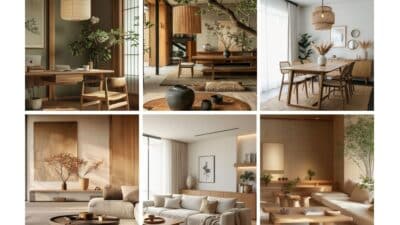Step into a home that feels alive, peaceful, and connected—where the outdoors greet you at every turn. Biophilic design is the art of inviting nature inside, blending elements like natural light, fresh greenery, earthy materials, and even soothing water features to create a living space that nurtures your well-being. With growing interest in natural living, this approach offers practical ideas anyone can use for a healthier, more welcoming home.
When you choose biophilic design, you do more than add decoration; you transform your space into a soothing retreat that supports mood, creativity, and calm. Whether you’re drawn to sun-soaked rooms, wooden accents, or a cozy corner full of plants, you’ll discover simple ways to make your home feel more vibrant and restorative.



Key Takeaways
- Biophilic design connects your home with nature for a calming effect.
- Using natural light, materials, and greenery brings instant benefits.
- Small changes create a lasting positive impact in your living space.
Understanding Biophilic Design
Biophilic design is about weaving elements of the natural world into your living spaces, blending nature and built environments. By mindfully including natural components, you can experience spaces that support comfort, relaxation, and health.
The Principles of Biophilic Design
The core idea behind biophilic design is to create a meaningful connection between humans and nature inside your home. This includes integrating features like natural light, outdoor views, and organic materials.
Biophilic interiors use a mix of strategies, such as:
- Direct experiences: living plants, water features, sunlight
- Indirect experiences: natural patterns, textures, and color palettes
- Spatial configurations: open layouts, nooks, and natural flow
You don’t need to turn your living room into a greenhouse. Even small touches—like a wooden table, a stone backsplash, or earthy colors—can help foster the sense of being around nature.
The Connection Between Nature and Interior Design
In biophilic design, your home becomes a bridge between you and the outdoors. Large windows that frame trees or gardens, houseplants that soften corners, and natural materials like bamboo or linen invite the outside world in.
This approach is rooted in the belief that people are happier and healthier when surrounded by reminders of the natural environment. For example, using:
| Natural Element | Example in Interiors |
|---|---|
| Plants | Potted greenery, moss art |
| Water | Indoor fountains, aquariums |
| Light | Skylights, sheer curtains |
| Materials | Cork floors, rattan chairs |
Small design decisions—like letting more daylight into your kitchen or displaying a bowl of stones—help make your home feel refreshing and inviting.
How Biophilic Design Enhances Well-Being
Introducing biophilic design into your interiors can benefit your mood, focus, and relaxation. Studies show that natural elements such as daylight and greenery can lower stress and increase satisfaction in everyday spaces.
You might notice improved air quality when adding plants or a better sense of calm from a nature-inspired color palette. Tactile elements like natural fabrics or wood surfaces can create a cozy, grounding effect.
By surrounding yourself with nature-inspired features—even in subtle ways—you can encourage a healthier, more balanced living environment.



Integrating Natural Materials
Natural materials introduce texture, warmth, and authenticity into your home. Surfaces like wood, stone, and terracotta set the foundation, while organic colors and textures add a distinct sense of comfort and grounding.
Choosing Wood, Stone, and Other Natural Surfaces
Choosing real wood for floors, cabinetry, or furniture brings in both visual appeal and durability. Hardwoods like oak and walnut give a rich look, while lighter woods such as pine or ash create an airy mood. Stone, whether granite countertops or slate tiles, offers a cool, stable touch.
You can combine different materials for interesting contrast. For example:
- Wood floors with stone feature walls
- Marble tabletops paired with bamboo décor
Natural surfaces often become central focal points in rooms. Their irregular patterns and tactile finishes add layers and richness that manufactured materials can’t match. Maintaining these surfaces usually means regular cleaning and, for wood, occasional oiling or sealing.
The Role of Terracotta in Home Spaces
Terracotta is an ancient material, often used in flooring, tiles, and decorative vessels. Its signature warm, earthy hue instantly makes a space feel cozy and inviting. Terracotta floors are especially effective at balancing moisture and temperature indoors.
You can use terracotta tiles for entryways or as a backsplash in the kitchen. Potted terracotta planters bring texture and subtle color to window sills or corners. The porous surface of terracotta helps regulate humidity when used in home environments.
Terracotta fits seamlessly with both rustic and modern aesthetics. Its natural variation means each piece is unique, adding a handmade feel to any setting.
Organic Textures and Earthy Colors
Organic textures, such as woven baskets, linen curtains, or wool rugs, layer in physical comfort and visual interest. These elements soften rooms and create a tactile dimension that more sterile materials lack. Mixing smooth finishes like stone with softer textures results in an engaging balance.
Earthy color palettes—think clay red, moss green, warm ochre, and muted browns—reflect the outdoors and work well alongside natural surfaces. You can use these colors on walls, accents, or soft furnishings for a cohesive look.
Simple changes, like swapping synthetic throws for cotton or wool, further enhance the sensory connection to nature. Patterns inspired by leaves, branches, or flowing water add subtle biophilic cues to your space.



Maximizing Natural Light
Natural light enhances your living space, supports your mood, and creates a strong connection to nature indoors. There are several effective ways to bring more sunlight into your home by focusing on window placement, creative architectural features, and clever interior design techniques.
Large Windows for Sunlit Interiors
Large windows are one of the most effective ways to bring natural light into your home. Floor-to-ceiling or expansive picture windows open rooms to abundant daylight while providing clear views of outdoor landscapes.
Consider orienting large windows toward the south to capture the most sunlight throughout the day. If privacy is a concern, use translucent curtains or frosted glass, which soften the light without sacrificing brightness.
Use window frames with slim profiles or minimal mullions to maximize the glass area. This approach increases the actual sunlight entering your space. In open-plan rooms, aligning windows across from each other can create a natural light corridor, making spaces feel even more open and inviting.
| Window Tip | Effect |
|---|---|
| Floor-to-ceiling | Increases brightness |
| South-facing | Maximizes sun exposure |
| Translucent glass | Softens harsh light |
Incorporating Skylights and Solar Tubes
Skylights and solar tubes are excellent for rooms where wall windows aren’t practical, such as bathrooms, hallways, or central interior spaces. Skylights allow overhead sunlight to flood rooms, providing light even in deeper floor plans.
Well-placed skylights work especially well in kitchens and bathrooms, where natural light boosts both utility and ambiance. You can choose fixed, vented, or even remote-controlled skylights for flexibility and fresh air options.
Solar tubes, or sun tunnels, use reflective pipes to channel sunlight from the roof down into rooms below. They fit well in areas with limited roof space and are less invasive to install than traditional skylights. Both solutions reduce the need for artificial light during the day.
Amplifying Daylight with Mirrors
Mirrors are a simple yet powerful tool for spreading natural light throughout your home. By placing mirrors opposite or adjacent to windows, you reflect sunlight deeper into the room, increasing both the brightness and the perceived space.
Consider using large wall mirrors or arranging several smaller mirrors in a gallery, especially in narrow corridors or smaller rooms. Mirrored furniture or decor can also contribute to bouncing sunlight around.
Try experimenting with different shapes and placements to suit your style and room layout. Combining mirrors with light-colored walls and minimalist decor will further enhance the luminous effect.



Bringing Plants and Greenery Indoors
Adding greenery to your home creates a calming, natural feel while also benefiting your well-being. The way you select, arrange, and maintain your indoor plants can influence the mood, air quality, and overall function of your spaces.
Selecting the Best Indoor Plants
When picking indoor plants, start with those that match your lifestyle and home conditions. Some plants need lots of sunlight and frequent watering, while others cope well with shade and dry air.
Easy options for nearly any space include pothos, snake plant (Sansevieria), and ZZ plant. These varieties are hardy, require minimal care, and tolerate lower light. If you have bright natural light, try species like fiddle leaf fig or rubber plant for bold, leafy statements.
Think about the mature size of each plant and the space you have available. Grouping plants with similar water and light needs simplifies care. Using pots in different heights or colors adds visual interest and helps define areas in open rooms.
Key Tips:
- Match plant type to lighting conditions
- Consider your willingness to water and maintain
- Mix different shapes and sizes for variety
Air-Purifying Plants for Better Wellness
Certain indoor plants stand out for their ability to filter and improve indoor air quality. NASA’s Clean Air Study highlights some of these, such as the peace lily (Spathiphyllum), spider plant, and snake plant, which can help reduce levels of pollutants like formaldehyde and benzene.
Arranging several air-purifying plants in living areas and bedrooms can make your space feel fresher. The snake plant is especially low-maintenance and tolerant of neglect. Ferns are another excellent choice; Boston ferns and maidenhair ferns thrive with a bit more humidity.
While air-purifying plants offer tangible benefits, remember that they supplement—not replace—other forms of good ventilation. Keep your plant’s leaves dust-free to ensure maximum air-cleaning potential.
List: Good Air-Purifying Options
- Snake plant
- Peace lily
- Spider plant
- Boston fern
- Rubber plant
Living Walls and Moss Walls
A living wall, sometimes called a vertical garden, is a dramatic way to introduce lots of greenery with a small footprint. These installations fit well in entryways, living rooms, or even kitchens. Living walls require a frame to hold soil or hydroponic systems along with integrated watering.
You can use a wide range of plants, including ferns, pothos, and philodendron, for lush, layered looks. Moss walls, made from preserved moss, offer a maintenance-free alternative. They bring texture and green color without watering or sunlight.
Living and moss walls can serve as natural art pieces. If you’re planning a DIY project, start small with a vertical arrangement of pots or a ready-made kit. Work with a professional for larger or more complex designs.
Table: Living Walls vs. Moss Walls
| Feature | Living Wall | Moss Wall |
|---|---|---|
| Maintenance | Regular watering | Low/None |
| Plant Types | Live, varied | Preserved moss |
| Sunlight Needed | Yes | No |
| Ideal Placement | Well-lit areas | Any interior area |
Designing Indoor Gardens
Indoor gardens can range from a cluster of countertop herbs to a full-scale conservatory. Start by choosing a location with suitable light, such as near a south- or east-facing window. Use raised planters, decorative trays, or simple pots to keep your garden organized and attractive.
Grow culinary herbs like basil, mint, or chives for both greenery and kitchen convenience. If you prefer ornamentals, group flowering plants with foliage types for year-round visual variety.
Automatic watering kits or self-watering pots can help with maintenance, especially if you travel or have a busy schedule. Vary plant heights and textures for a more natural look. Use stones, decorative mulch, or small figurines to personalize your garden and make it a functional feature in your daily life.
Incorporating Water Features
Adding water features to your space is a direct way to introduce tranquility and a soft connection to nature. From gentle fountains to lush green displays beside ponds, you can find options that suit your home’s character and your daily routines.
Water Element Ideas for Tranquility
Water features create a soothing atmosphere by providing calm sounds and visual appeal. Tabletop fountains are easy to add to small rooms or offices and deliver gentle streams of water that reduce stress.
For larger spaces, consider a wall-mounted waterfall or a reflective pond. These features not only look striking but can also help mask unwanted noise from outside. In bathrooms, a small indoor waterfall brings a spa-like feel.
If you have a patio, a freestanding fountain can become the focal point with minimal maintenance. Many modern options come with energy-efficient pumps and are easy to install. Whether you choose a modern water wall or a classic stone bowl, focus on designs that match your aesthetic and the acoustics you prefer.
Comparison Table of Water Features
| Feature Type | Space Needed | Sound Level | Maintenance |
|---|---|---|---|
| Tabletop Fountain | Minimal | Low | Low |
| Wall-Mounted Waterfall | Moderate | Medium | Medium |
| Reflective Pond | Significant | Quiet | Moderate |
| Freestanding Fountain | Flexible | Medium | Low-Moderate |
Combining Water and Greenery
Water works best in biophilic design when paired directly with indoor plants or living walls. Place potted tropical plants, such as philodendrons or ferns, near your fountain for a more vibrant effect. This not only looks natural but supports a healthier indoor environment by increasing humidity.
You can also float aquatic plants, such as water lilies or lotus, in small interior ponds. These plants help purify the water while adding a soft, organic touch. In smaller spaces, position vining plants around a tabletop fountain to achieve a lush, cascading look.
Try grouping stones, pebbles, and moss with your water feature. This combination improves the overall natural feel and encourages a multilayered sensory experience. Even a simple arrangement of greenery around a mini waterfall will enhance the sense of retreat and connection to the natural world.
Benefits and Lasting Impact of Biophilic Spaces
Biophilic design offers measurable improvements to your everyday comfort, health, and well-being at home. It brings natural elements inside, fostering spaces that restore your mood, support healthy sleep, and help you reduce your environmental impact.
Boosting Mood and Reducing Stress
When you incorporate natural light, greenery, and organic materials into your living spaces, your mental well-being often improves. Studies show that access to nature reduces stress hormones and helps stabilize your mood.
Visual connections to plant life, wood, and water features can increase positive emotions and lower anxiety. Homes designed with large windows and indoor gardens create everyday opportunities for mental restoration.
Natural patterns, textures, and earthy colors can also make downtime more relaxing. A biophilic home provides mini escapes from digital overload and daily stressors, helping you feel calmer and more focused.
Enhancing Circadian Rhythms and Sleep
Your sleep cycle relies on exposure to changing natural light, known as circadian rhythms. Well-placed windows and skylights in biophilic design support this by maximizing daylight and minimizing harsh artificial lighting.
You benefit from:
- Brighter mornings that wake you gently
- Evenings with softened, warm-toned lighting
- Fewer disruptions to your sleep patterns
This natural approach promotes better melatonin production and deeper sleep. Biophilic elements like plants do more than soften the environment; they naturally filter indoor air, which can also support easier breathing during the night.
Supporting Sustainable Living
Biophilic design encourages you to build and decorate with local, renewable, and low-impact materials, reducing environmental strain. Homes that use native plants and natural ventilation systems help lower your energy use.
You can decrease your reliance on artificial heating, cooling, and lighting by maximizing shade, fresh air flow, and passive solar gain. Eco-friendly choices—such as bamboo flooring, clay, or reclaimed wood—further reinforce your connection to nature.
These shifts don’t just reduce your carbon footprint. They create homes that are healthier, more resilient, and aligned with broader goals for environmental sustainability. You gain comfort and well-being while supporting the health of the planet.






